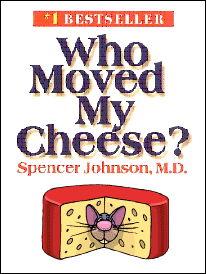Online Course
Nurs 659 - Organizational/Professional Dimensions
Module 11: Managing Innovation and Change
The Challenge of Innovation and Change
Who Moved My Cheese? A simple parable that reveals profound truths about change. It is an amusing and enlightening story of four characters who live in a "Maze" and look for "Cheese" to nourish them and make them happy. A simple parable that reveals profound truths about change. It is an amusing and enlightening story of four characters who live in a "Maze" and look for "Cheese" to nourish them and make them happy. Two are mice named Sniff and Scurry. And two are "little people" -- beings the size of mice who look and act a lot like people. Their names are Hem and Haw. "Cheese" is a metaphor for what you want to have in life -- whether it is a good job, a loving relationship, money, a possession, health, or spiritual peace of mind. And "The Maze" is where you look for what you want -- the organization you work in, or the family or community you live in. In the story, the characters are faced with unexpected change. Eventually, one of them deals with it successfully, and writes what he has learned from his experience on the maze walls (The Handwriting On the Wall). Change can be a blessing or a curse, depending on your perspective. The message of Who Moved My Cheese? is that all can come to see it as a blessing, if they understand the nature of cheese and the role it plays in their lives. (Reference: http://www.amazon.com/exec/obidos/ASIN/0399144463/calscientist-20/103-1449307-5800662?dev-t=1X1DYMMDWCNFWBGZ82G2) |
The Handwriting on The Wall
---Dr. Spencer Johnson
Change happens
They keep moving the cheese
Anticipate change
Get ready for the cheese to move
Monitor change
Smell the cheese often so you know when it is getting old
Adapt to change quickly
The quicker you let go of old cheese, the sooner you can enjoy the new cheese
Change
Move with the cheese
Enjoy change
Savior the adventure and enjoy the taste of new cheese
Be ready to change quickly and enjoy it again
They keep moving the cheese!
The point of this introduction is that the above reference has been widely used as a business and personal life management tool. It is a fun reading paperback that has formed the foundation for many management seminars, and it is used to facilitate our understanding of change. The bottom line, as noted, is that, "they keep moving the cheese". How will you respond with the continued movement of the cheese? Your task is to view the handwriting on the wall, and determine how this handwriting will assist you as you meet the challenges of continued change in your personal and professional life.
________________________________________________________________________________
Among the many pressing forces for change, the outcomes most always dictate a need for work redesign to meet the challenges. Tim Porter-O'Grady, distinguished author and lecturer, has noted that the scope and intensity of change force us to recognize how these new realities of change affect work, its structure and the design of new models. In an earlier publication (JONA, Volume 26, Number 1, pp.46-53, January 1996) Dr. O'Grady lists seven basic rules for successful redesign:
- No Exceptions
- Read the signposts
- Construct a vision
- Empower the center
- Construct new architecture
- Have a plan of action
- Evaluate, adjust, evaluate again
Patricia Edens (2005) further provides an in-depth look at the forces of change, and the appropriate strategies for success. Review: Workplace Reengineering, Reorganization, and Redesign From Nursing Management: Principles and Practice. http://www.medscape.com/viewarticle/511808_print
"Exercise: Think back to a situation of organizational redesign that you were involved in. Following the review of the article above, determine what would you have done differently? Which of the handwriting lessons did you learn in the process?
If you have the opportunity, read "Who Moved My Cheese?
This website is maintained by the University of Maryland School of Nursing (UMSON) Office of Learning Technologies. The UMSON logo and all other contents of this website are the sole property of UMSON and may not be used for any purpose without prior written consent. Links to other websites do not constitute or imply an endorsement of those sites, their content, or their products and services. Please send comments, corrections, and link improvements to online@son.umaryland.edu.
